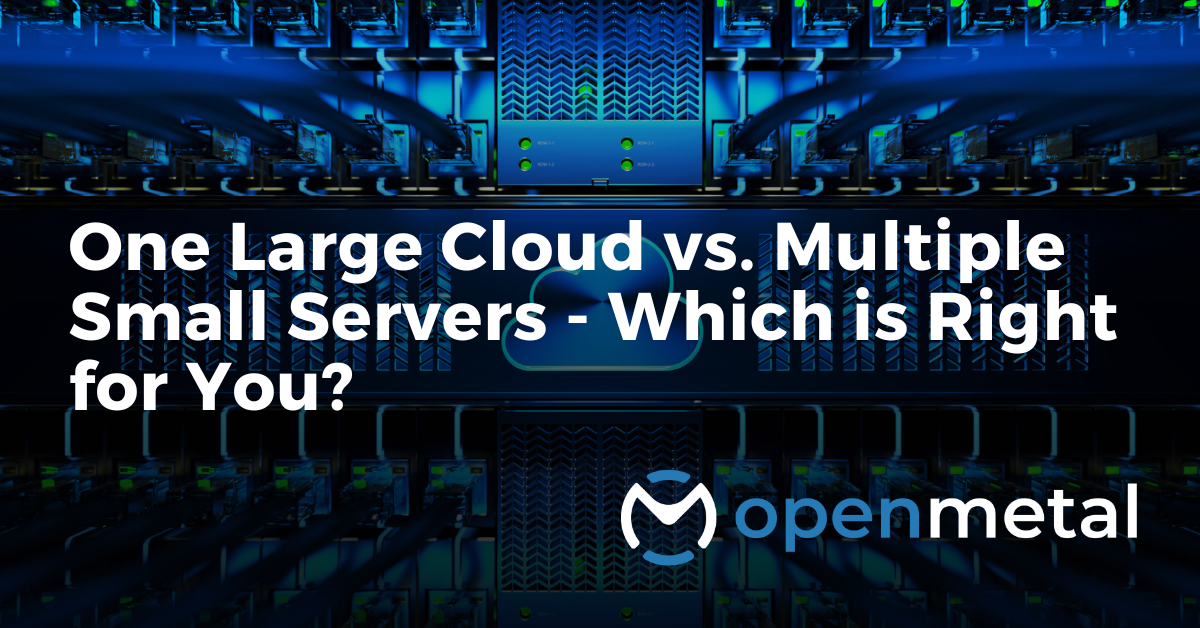We’re no strangers to helping our users find the best cloud solution for their needs. There’s far more to consider than just what type of deployment model is the right fit!
We recently spoke with an organization interested in purchasing multiple small individual servers. Was this truly the best solution for their use case? Or would it benefit them to instead purchase one larger dedicated cloud and partition it into VMs to fit their applications?
The solution for them, and for anyone else debating the same, must take into account a variety of different factors. Here’s a breakdown of when consolidation probably makes sense, when it might not be the best approach, and the benefits of each method.

Advantages of a Single, Larger Private Cloud
Efficiency and Resource Optimization
- Dynamic Resource Allocation: A larger cloud allows you to pool resources and strategically allocate them to VMs as needed. This means you can easily customize CPU, memory, and storage for each VM without being constrained by the limitations of small individual servers.
- Reduced Wasted Resources: With this dynamic allocation ability, you avoid over-provisioning resources to individual servers “just in case.” This leads to higher utilization rates and minimizes wasted capacity.
- Improved Performance: By optimizing VMs, you can ensure that applications have exactly the resources they need when they need them, leading to improved performance and user experience.
Cost Savings
- Lower Hardware Costs: Consolidating onto fewer physical servers reduces upfront hardware costs and ongoing maintenance expenses.
- Reduced Energy Consumption: Fewer servers mean lower energy consumption, resulting in lower electricity bills and a smaller carbon footprint.
- Decreased Licensing Costs: In some cases, software licenses are based on the number of physical servers. Consolidating can reduce the number of licenses required, leading to significant cost savings.
- Lower Administrative Overhead: Centralized management and automation reduce the time and resources required for IT administration, freeing up staff for other tasks.
Greater Control and Flexibility
- Centralized Management: A single cloud environment provides a centralized platform for managing all your resources, including VMs, storage, and networking. This simplifies administration and makes it easier to enforce security policies and compliance requirements.
- Rapid Scalability: You can quickly scale your resources up or down to meet changing demands, ensuring that your applications always have the resources they need.
- Increased Agility: The flexibility of a private cloud allows you to respond rapidly to new business opportunities (also white label ones!), adapt to changing market conditions, and enter new markets quickly.
- Customization: With a private cloud from OpenMetal, you have root access and complete control over your cloud environment, allowing you to customize it to meet your specific needs and requirements.
Simplified Management
- Centralized Administration: Manage all your resources from a single interface, simplifying tasks like provisioning new VMs, monitoring performance, and applying security updates.
- Automation: More easily automate routine tasks like patching, backups, and deployments, freeing up IT staff from manual work.
- Streamlined Operations: Simplified management leads to more efficient IT operations and reduced operational costs.
Enhanced Security
- Centralized Security Policies: Implement and enforce consistent security policies across your entire cloud environment.
- Access Control: Control access to your resources with granular permissions and role-based access control.
- Improved Monitoring: Monitor your environment for security threats and vulnerabilities from a central location.
- Data Protection: Implement data protection measures like encryption and backups to safeguard your critical information.
Reduced Hardware Maintenance
- Fewer Physical Servers: Consolidating to a single cloud reduces the number of physical servers you need to maintain, reducing hardware-related tasks like repairs, upgrades, and replacements.
- Simplified Lifecycle Management: Managing the lifecycle of fewer servers simplifies hardware refresh cycles and reduces associated costs.
- Increased Uptime: Modern virtualization platforms offer features like live migration and high availability, minimizing downtime and ensuring business continuity.
When to Consider One Large Cloud
Here are some situations where a single larger private cloud really shines, and downsides are likely to be minimal:
You Have Consistent, Predictable Workloads
- Stable Resource Demands: When applications have relatively stable resource needs and predictable growth patterns, a single larger cloud provides an ideal environment for efficient resource allocation.
- Long-Term Planning: If you can forecast your resource needs with reasonable accuracy, you can right-size your cloud environment from the start and avoid over-provisioning or more frequent upgrades.
- Simplified Capacity Management: Predictable workloads make it easier to manage capacity and ensure that your cloud environment can handle future growth without significant disruptions.
You Have Limited IT Staff
- Centralized Management: A consolidated environment reduces management overhead. With fewer physical servers and a centralized management platform, a smaller IT team can effectively handle maintenance, updates, and troubleshooting.
- Automation Opportunities: A single cloud environment provides more opportunities for automation, further reducing manual tasks and freeing up IT staff for other work.
- Simplified Skillset Requirements: Managing a single cloud environment may require a less diverse set of IT skills compared to managing a heterogeneous environment with multiple smaller servers.
Your Applications are Designed for Scalability
- Cloud-Native Applications: Modern applications, especially those built with microservices architectures or designed for cloud deployment, are inherently scalable and well-suited for a single larger cloud environment.
- Horizontal Scaling: A single larger cloud provides the platform to easily scale applications horizontally by adding or removing VMs as needed, ensuring optimal performance and resource utilization.
- Elasticity: Cloud-native applications can take advantage of the elasticity of a larger cloud environment, automatically scaling resources up or down in response to demand.
You’re Interested in Long-Term Strategic Investment
- Reduced Total Cost of Ownership (TCO): While the initial investment in a larger cloud setup might seem higher, it can lead to significant cost savings in the long run due to lower hardware costs, reduced energy consumption, and decreased administrative overhead.
- Future-Proofing: A well-designed private cloud can be scaled and adapted to meet future needs, providing a flexible and scalable foundation for your IT infrastructure.
- Competitive Advantage: A robust and efficient consolidated private cloud can provide a competitive advantage by enabling faster innovation, improved agility, and reduced time to market for new products and services.
Essentially, when you have the in-house skills, predictable workloads, and a focus on long-term efficiency, a single larger private cloud becomes a powerful asset with minimal drawbacks.

Advantages of Smaller, Individual Servers
Enhanced Isolation and Security
- Reduced Blast Radius: If one server experiences a security breach or technical failure, the impact is limited to that specific server, preventing the issue from spreading to other applications or data.
- Granular Security Policies: Implement highly specific security configurations and access controls for each server, tailoring them to the unique needs of the applications and data they host.
- Regulatory Compliance: Easily meet strict compliance requirements (e.g., HIPAA for healthcare data, PCI DSS for payment information) by isolating sensitive data on dedicated servers.
- Multi-Tenant Environments: When hosting applications or services for multiple clients, individual servers provide clear separation and prevent one client’s activities from affecting others.
Specialized Hardware and Optimization
- Tailored Hardware Configurations: Choose servers with specific hardware components (e.g., GPUs for machine learning, high-speed network interfaces for real-time processing) optimized for the applications they’ll run.
- Performance Tuning: Fine-tune each server’s operating system, network settings, and other configurations to maximize the performance of its specific workload.
- Resource-Intensive Applications: Isolate demanding applications on dedicated servers to prevent them from impacting the performance of other applications.
Flexibility and Scalability
- Gradual Scale-Out: Start with a small number of servers and gradually add more as your needs grow. This “pay-as-you-go” approach allows for cost-effective scaling.
- Heterogeneous Environments: Easily accommodate applications with different operating system or software requirements by deploying them on separate servers.
- Technology Diversification: Avoid vendor lock-in and single points of failure by using servers from different vendors or with different hardware configurations.
Fault Tolerance and Disaster Recovery
- Increased Redundancy: Distributing applications across multiple servers increases redundancy. If one server fails, the others can continue operating, minimizing downtime.
- Simplified Disaster Recovery: Smaller servers can be more easily replicated or backed up, simplifying disaster recovery efforts and reducing recovery time.
- Geographic Distribution: Deploy servers in different geographic locations to protect against regional outages or natural disasters.
Cost-Effectiveness in Specific Scenarios
- Legacy Applications: Running legacy applications on smaller, dedicated servers can be more cost-effective than migrating them to a virtualized environment.
- Specialized Hardware Needs: If you need specific hardware for certain tasks, it might be more cost-effective to purchase a smaller server with that specific hardware than to overprovision a larger VM.
- Reduced Licensing Costs: Some software licenses are tied to physical cores or sockets. Using smaller servers can be more cost-effective than licensing software for a larger, consolidated environment.
When to Consider Multiple Smaller Servers
While consolidating to a single private cloud offers many different benefits, there are situations where using multiple smaller servers might be more appropriate.
You Have Unique Application Requirements
- Legacy Systems: Older applications might not be designed for virtualization or cloud environments. They may perform better on or have specific dependencies that require dedicated hardware.
- Resource-Intensive Applications with Unique Requirements: Applications with very specific hardware needs (e.g., GPUs for machine learning, high-speed network interfaces for real-time data processing) might be better isolated on dedicated servers.
- Licensing Costs: Some software licenses are tied to physical cores or sockets. Running such software on a large VM in a shared environment could become prohibitively expensive compared to using smaller servers.
You Need High Isolation and Security
- Sensitive Data: Highly sensitive data (e.g., financial transactions, patient records) might require strict isolation to meet regulatory compliance (HIPAA, PCI DSS). Separate servers enhance security by limiting the impact of a potential breach.
- Testing and Development: Isolating development and testing environments on separate servers prevents conflicts with production systems and allows for more controlled experiments.
- Microservices with Specific Security Requirements: While microservices generally thrive in a consolidated environment, some services might handle particularly sensitive data or require stricter security measures, justifying their isolation.
You’re Working With Edge Computing and Distributed Architectures
- Low Latency Applications: Applications that require minimal latency (e.g., online gaming, real-time analytics) benefit from edge computing, where smaller servers are deployed closer to users or data sources.
- Content Delivery Networks (CDNs): CDNs rely on geographically distributed servers to cache content and deliver it quickly to users worldwide.
- IoT and Data Acquisition: In IoT scenarios, smaller servers placed near devices can efficiently collect and process data before sending it to a central location.
You’re Building for Fault Tolerance and Disaster Recovery
- Increased Redundancy: Distributing applications across multiple servers increases redundancy. If one server fails, the others can continue operating, minimizing downtime. (Note that with a solution like OpenMetal’s hosted private cloud, our base offerings consist of our Private Cloud Core – three hyperconverged servers for redundancy.)
- Simplified Disaster Recovery: Smaller servers can be more easily replicated or backed up, potentially simplifying disaster recovery efforts.
Important Note: Even when using multiple smaller servers, virtualization can still play a role. You can use virtualization to consolidate multiple applications onto each physical server, improving resource utilization and simplifying management.
In essence, while a single larger private cloud offers a number of advantages, consider your application architecture, security needs, scalability requirements, and budget constraints to determine if multiple smaller servers might be a better fit for your organization.
Conclusion
The decision to consolidate to a single, larger private cloud or use multiple smaller servers of course depends on your specific needs and circumstances. Evaluate your requirements, consider the advantages and disadvantages of each approach, and choose the solution that best aligns with your business goals.
Want to explore OpenMetal’s hosted private cloud for your infrastructure needs?
Apply for Trial View Catalog & Pricing Request a Quote
Questions? Contact us.



































